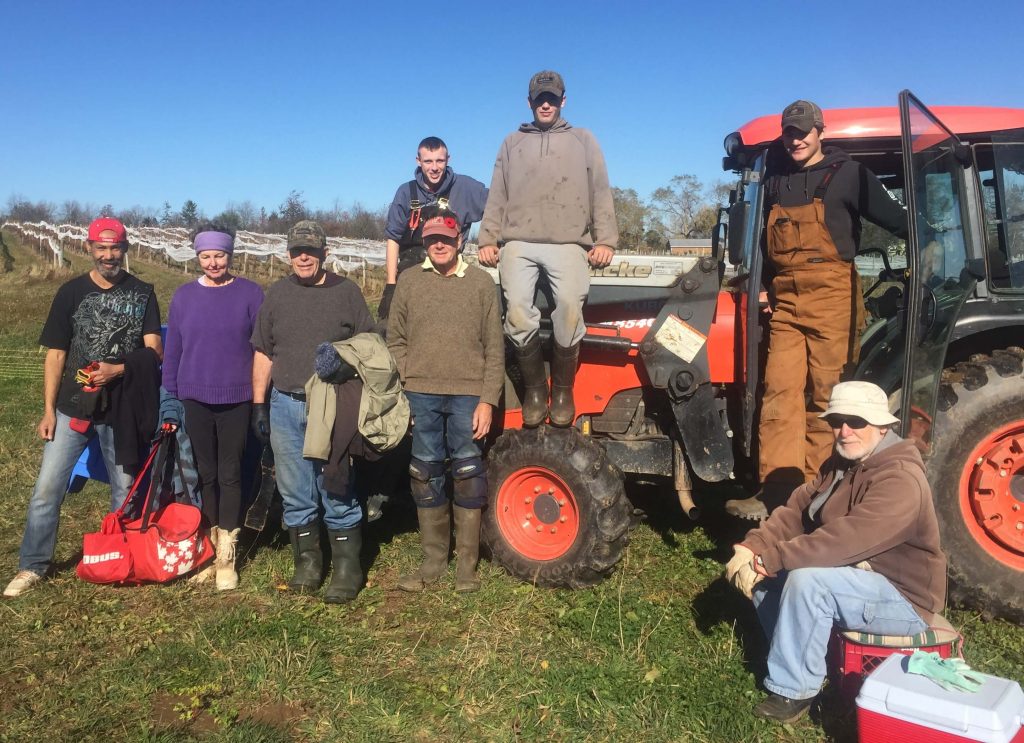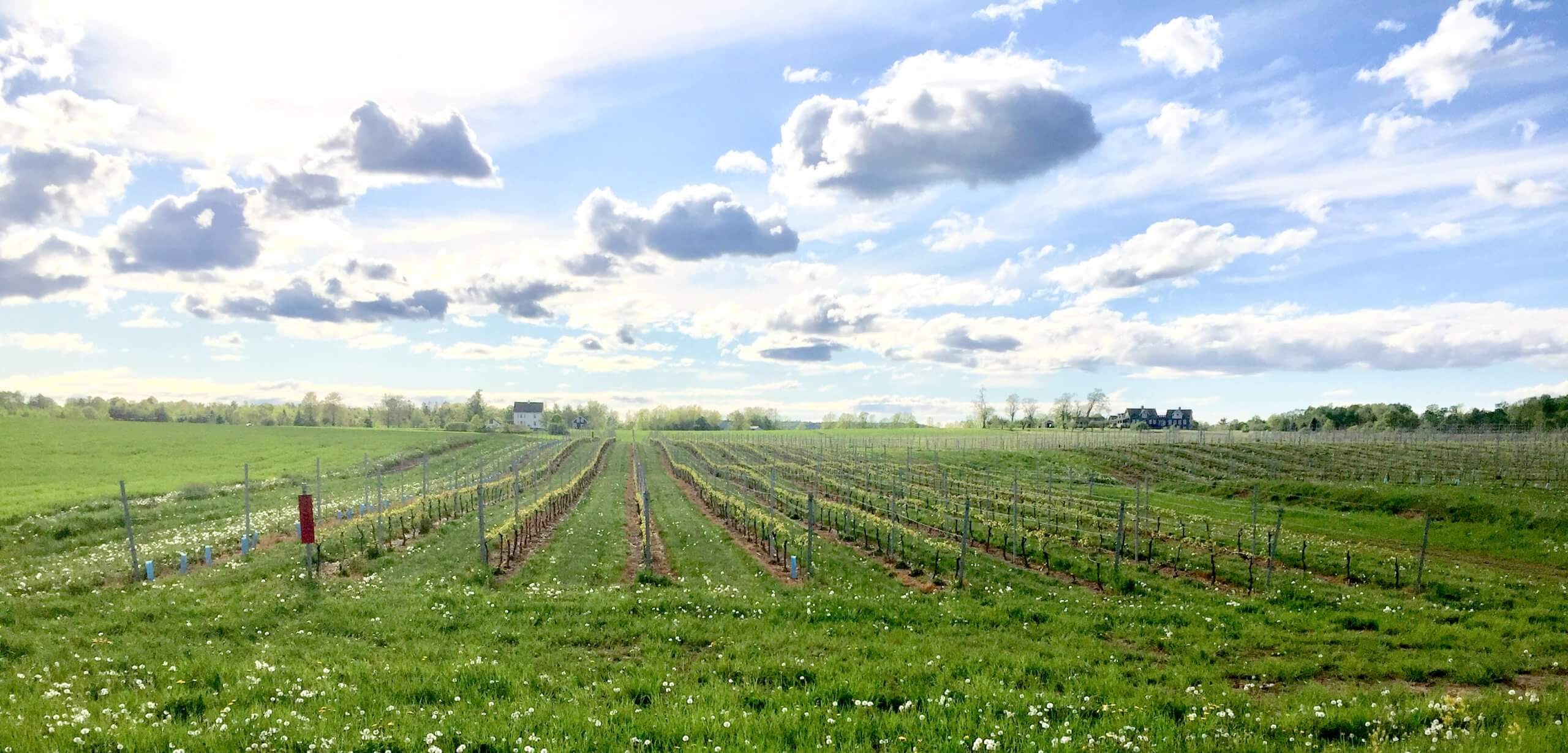Summary
2019 was a year in which the long term damage caused by the frost of June 4, 2018 and the subsequent harsh winter of 2018-19 became evident. One third of the vinifera, vidal, seyval and Geisenheim-318 died or were severely damaged. All plants were 5 years old or younger. Root damage was thought to be severe in these vines which led to an aggressive summer foliar nutrient program (described below). KDL (Agromart – Truro 902-895-2857 – local representative Alyson Bremner 902-890-5451) was applied 3-4 times in late summer and fall to encourage ripening and hardening off of the vine shoots. Soil microrganisms were low according to SAP testing and a program of Biomax drenching was started. None of these problems affected the truly hardy varieties, Marquette and Petite Pearl. Chardonnay 548/101-14 was the least affected vinifera. Grape yields were low/acre due to the large number of dead/damaged vines but for the vines that escaped damage the yield was satisfactory. Ripening was delayed but Brix for all varieties eventually reached 17-21. Picking was completed on November 3 with harvest of the Vidal. The Petite Milo was the first to bud out in the spring and the first to be picked (September 26). It is not clear whether the damaged vines will regenerate next year or die out. Another harsh winter could finish them off.
Switch from organic to sustainable farming
Weed control was difficult with the grape hoe because of damage to the many new vines planted to replace the dead vines from the 2018 frost and following harsh winter. Organic practices do not allow synthetic herbicides to be used so our organic certification was terminated and Ignite was used to control weeds. Trunk damage in the vinifera during the early years of the vineyard seemed to be accentuated by the use of grow tubes (trunks failed to harden off due to aggressive growth in the tube) as well as higher tractor speeds (5-6 km/hr – 2 km/hr may have been more appropriate). Choice of nutrients was markedly limited by seemingly arbitrary selection of compounds suitable for organic certification. There did not appear to be any financial incentive offered by the wineries for organic grapes. Finally organic farming is not necessarily environmentally friendly. There is a lot more tractor use as a result of more frequent spraying. The frequent tractor use compacts the earth and produces a lot of carbon dioxide.
Vine nutrition
Sap from the grape vine leaves provided a new way of analyzing the nutritional status of the grapevines. The samples were taken separately from new and old leaves and sent to NovaCropControl located in The Netherlands (sent by Agromart). The interpretation was complicated but basically showed what was being absorbed by the plant and whether the nutrients were being utilized. Despite adequate micronutrients in the soil, the root system was not taking up these nutrients (the root system was likely damaged by the frost of 2018 and the harsh winter of 2018-19. This was probably aggravated by the dense clay soil that forced the vinifera vine roots to grow laterally). This was, in part, remedied by spraying Sysstem Mg (1L/ac) and Sysstem Cal (1L/ac) along with Zinc +4 (1 L/ac). To combat low phosphorus Agro-K 3-18-18 (1 L/ac) was sprayed. Low Zn and Iron was treated by spraying Agro-K Iron DL 5.5% (1 L/ac) and Agro-K Zinc DL 10% (1 L/ac). Agro-K Symspray (250 ml-1 L) was applied every 2 weeks from early leaf growth to mid August. Depending on the sap analysis Boron (0.4 kg/ac) and Molybdenum may need to be applied. SAP testing may indicate a low silica level which is a measure of soil microbial activity. This can be remedied by applying multiple drenches of BioMax (2L/ac). A novel approach would be to consider spraying Agro-K 0-0-20 after harvest (assuming the canopy is in good shape) to load the buds in preparation for spring. Unfortunately late fall ripening prevented this at Johnston Vineyards.
Preventing downy mildew in a “bad year”
The current approach to disease control at Johnston Vineyards is to use organic pesticides whenever possible with the goal of protecting beneficial organisms and wildlife. Only organic pesticides were used this year. To get an early start on control of mildew, Purespray Green (4 L/ac), a dormant mineral oil was applied just before bud break. Once the vines leafed out sulfur (Kumulus 1.6 kg/ac) was sprayed for control of powdery mildew and none appeared. It was also very effective for controlling deer damage as long as it was sprayed frequently enough to cover new growth. For downy mildew, copper compounds were used, including Cueva (used with increasing confidence as a replacement for copper 53 as the season progressed). It was preferred due to the small amount of copper applied in a vineyard with high copper levels. It was applied every 10 days rain or shine at a dose of (0.5-1% solution) to vinifera vines. The hybrids were sprayed once early in the season and not again. No downy mildew occurred on the hybrids and very little appeared on the vinifera. This occurred despite a “bad year” for mildew. Serifel (0.1 kg/ac) and Serenade (0.3 kg/ac) were each applied once for control of Botrytis. Despite leaving all viniferas on the vine into late October and early November very little Botrytis occurred.
Birds and Raccoons!



No netting was used on the 30 acre vineyard. Two wailers were used, each advertised to cover 10 acres (Phoenix Agritech -Debert, NS 902-662-2444). They were less effective along the edge of their range once the brix reached 18. These were supplemented by 4 portable devices (UltraSon 650) available from Klaus Sudbrack (506-533-4301). Three Triple John cannons from Critters B Gone (Suzanne 902-788-5498) were also used and moved to areas in the vineyard when brix reached 18 or greater. Red grapes were of more interest to birds that white. We captured 12 raccoons, one skunk and one domestic cat, all outside the electrified 3 km raccoon fence (Gallagher M1800i charger)! The skunk was removed by throwing a blanket over the trap before releasing it in a distant location. Unlike dogs, the last 2 species don’t eat grapes.
Late ripening and early fall frost threat

All vineyards in Nova Scotia were prone to late ripening due to the cold spring of 2019. Brix at Johnston Vineyards is generally higher than at surrounding vineyards. This is likely due to a number of reasons. 1. An aggressive KDL foliar spray program was implemented that included 3 applications starting early August and finishing a couple of weeks before picking. 2. An absence of cool air off the Minas Basin due to the causeway blocking the Avon River along with generally warmer temperatures in the Upper Falmouth region. 4. Close attention to nutritional requirements during the growing season.








